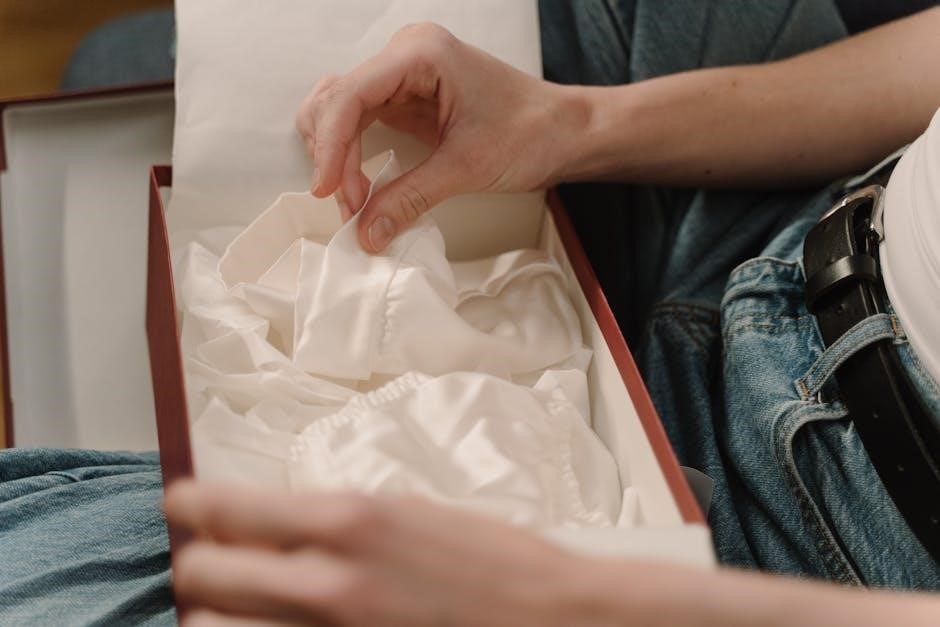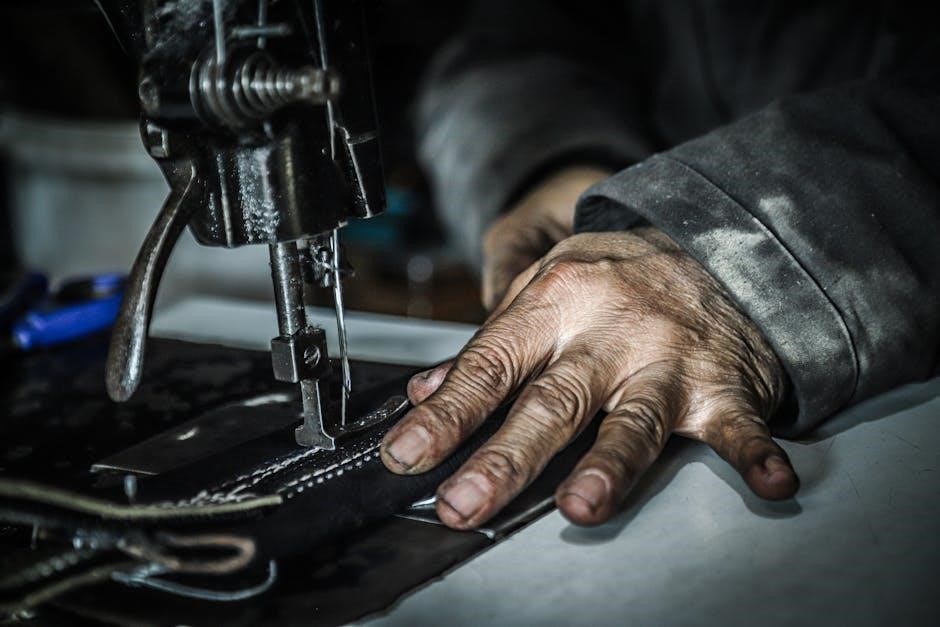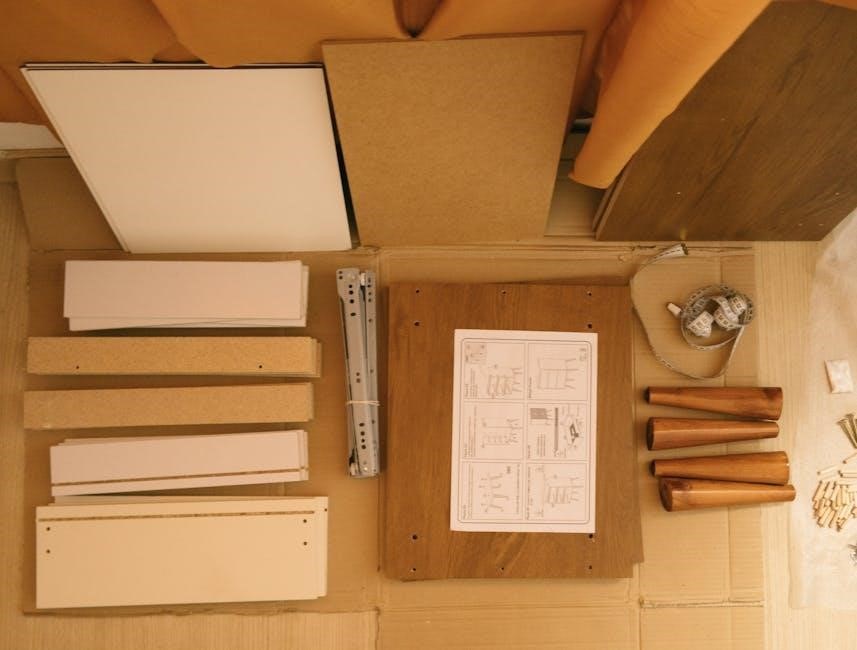
Welcome to your New Home sewing machine! This comprehensive manual guides you through setup, features, and maintenance. Discover troubleshooting tips and enhance your sewing experience. Read carefully to unlock your machine’s full potential and create with confidence.

Importance of the Instruction Manual
The instruction manual is essential for understanding your New Home sewing machine’s features, setup, and maintenance. It provides troubleshooting tips and ensures safe operation. Referencing the manual helps prevent errors, enhances sewing performance, and prolongs the machine’s lifespan. Always keep it handy for guidance.
Safety Precautions
Safety is paramount when operating your New Home sewing machine. Always read and follow the instructions in this manual to ensure safe and proper use. Keep the machine out of reach of children and pets to avoid accidents.
- Never touch electrical parts with wet hands or while standing on a damp surface to prevent electric shock.
- Avoid wearing loose clothing or jewelry that could get caught in moving parts.
- Keep the work area well-lit to maintain clear visibility of your stitching and machine components.
- Turn off the machine when making adjustments, changing needles, or threading to prevent unexpected startup.
- Use only genuine New Home accessories and parts to ensure compatibility and safety.
- Never sew over pins, as this can damage the machine or cause injury.
- Regularly inspect the machine for worn or damaged parts and address them promptly.
Failure to follow these precautions may result in injury or machine damage. Always refer to the manual for specific safety guidelines tailored to your New Home sewing machine model.
Understanding Machine Features

Understanding the features of your New Home sewing machine is essential to maximizing its potential and enhancing your sewing experience. Modern models, such as the New Home NLB and NH series, come equipped with a variety of functions designed to streamline your sewing process.
One of the key features is the stitch selection mechanism, which allows you to choose from a range of built-in stitches, including straight stitch, zigzag, and decorative patterns. Adjusting the stitch length and width ensures precise control over your fabric. Additionally, many models feature a reverse stitch option to secure seams.
The tension control dial is another critical feature, enabling you to adjust thread tightness for different fabric types. Proper tension ensures smooth stitching and prevents fabric puckering or thread breakage. Some models also include automatic tension settings for convenience.
Presser feet are interchangeable, catering to specific tasks like zipper installation, buttonholes, and quilting. The free-arm design allows easy access to hard-to-reach areas, such as cuffs and sleeves. Advanced models may include a built-in needle threader and automatic shut-off for safety.
Understanding these features empowers you to tackle various sewing projects with confidence. Explore your machine’s capabilities and experiment with different settings to achieve professional-quality results.
Regular Maintenance

Regular maintenance is crucial to ensure your New Home sewing machine operates smoothly and lasts for years. Start by cleaning the machine after each use, removing lint and debris from the bobbin area, tension discs, and feed dogs. Use a small brush or compressed air for this purpose.
Oiling is another essential step. Refer to your manual to locate the oil ports and apply a few drops of sewing machine oil. Avoid over-oiling, as it can attract dust and cause mechanical issues. Turn the handwheel gently to distribute the oil evenly throughout the internal components.
Check the needle frequently and replace it if it becomes bent or dull. A dull needle can cause poor stitch quality and fabric damage. Always use the correct needle type for your fabric to maintain optimal performance.
Inspect the bobbin and bobbin case for lint buildup and ensure they are properly seated. Incorrect bobbin placement can lead to thread jams and inconsistent stitching. Store your machine in a dry, cool place to prevent rust and moisture damage.
For advanced maintenance, consider having your machine serviced by a professional every 1-2 years. Regular upkeep ensures your New Home sewing machine remains reliable and continues to deliver excellent results for all your sewing projects.

How to Obtain the Instruction Manual
Access your New Home sewing machine manual by downloading it from the manufacturer’s website or purchasing a hard copy. Visit the official site, enter your model number, and download the PDF. Hard copies are also available for purchase from authorized dealers or online retailers.
Downloading from Manufacturer’s Website
Downloading the instruction manual for your New Home sewing machine from the manufacturer’s website is a convenient and cost-effective option. Begin by visiting the official website of the New Home Sewing Machine Company or reputable platforms like ManualsLib. Navigate to the “Support” or “Manuals” section, where you’ll typically find a search bar to enter your machine’s model number. Ensure you have the correct model number, usually located on the machine’s serial plate or in the original packaging. Once you’ve entered the model number, select the appropriate manual from the search results. Manuals are often available in PDF format, allowing you to download and save them to your device or print them for easy reference. This method is free, quick, and ensures you have the most accurate and up-to-date instructions for your specific machine. Many websites also offer additional resources, such as troubleshooting guides or maintenance tips, to enhance your sewing experience. By downloading the manual, you can access it anytime, making it a practical solution for both new and experienced users.
Purchasing a Hard Copy
If you prefer a physical copy of the New Home sewing machine instruction manual, purchasing a hard copy is a reliable option. Many manufacturers, including New Home, offer printed manuals for sale on their official websites or through authorized distributors. Simply visit the manufacturer’s website, navigate to the “Support” or “Manuals” section, and search for your specific machine model. Follow the prompts to purchase and have the manual shipped directly to your doorstep. Additionally, third-party retailers like Amazon or specialty sewing stores often carry a wide range of sewing machine manuals, including those for vintage or hard-to-find models. Prices vary depending on the model and rarity, with most ranging from $5 to $20 for standard manuals. For rare or vintage models, prices may be higher, reflecting their collectible value. Purchasing a hard copy ensures you have a tangible guide that’s always accessible, even without internet connectivity. This is particularly useful for those who prefer flipping through pages or keeping the manual near their sewing area for quick reference. Ensure authenticity by buying from trusted sources to avoid low-quality reproductions. A hard copy is a practical investment for sewists who value convenience and durability.

Key Sections of the Manual
The New Home sewing machine manual includes essential sections like Setting Up the Machine, Basic Sewing Operations, and Troubleshooting Common Issues. These sections provide clear guidance for initializing your machine, mastering fundamental stitches, and resolving technical problems efficiently to ensure smooth operation and optimal performance.
Setting Up the Machine

Setting up your New Home sewing machine is an essential first step to ensure optimal performance and safety. Begin by carefully unboxing and inspecting the machine for any damage; Place it on a stable, flat surface, away from direct sunlight and moisture. Familiarize yourself with the machine’s components, such as the spool pins, bobbin case, and presser foot.
- Attach any included accessories, like the sewing table or extension arm, following the manual’s instructions.
- Thread the machine according to the diagram provided in the manual, ensuring the thread flows smoothly through the tension discs and take-up lever.
- Wind and insert the bobbin correctly, making sure it is seated properly in the bobbin case and the thread is pulled through the machine’s guides.
- Test the machine by sewing a straight line on scrap fabric to ensure proper stitching and tension balance.
Refer to the manual for specific guidance tailored to your model, such as the New Home NLB or NH, to ensure a seamless setup process and enjoy a flawless sewing experience.
Basic Sewing Operations
Mastering basic sewing operations is crucial for getting the most out of your New Home sewing machine. Start by threading the machine correctly, ensuring the thread flows smoothly through the tension discs and take-up lever. Select the appropriate stitch type for your fabric, whether it’s a straight stitch for cotton or a zigzag stitch for stretchy materials.
- Place the fabric under the presser foot, aligning the edge with the machine’s guide.
- Lower the presser foot gently to secure the fabric in place.
- Hold the fabric steady with one hand and slowly turn the handwheel or press the start button to begin sewing.
- Use the reverse stitch button to secure the beginning of your seam, then continue sewing forward.
- Keep the fabric moving at a steady pace to maintain even stitches.
For backstitching, press the reverse button and sew a few stitches before continuing forward. This ensures strong seam starts and finishes. Always refer to your New Home manual for model-specific instructions, such as those for the NLB or NH models, to ensure optimal performance and avoid common mistakes. Regular practice will help you become comfortable with these operations, making your sewing projects faster and more precise;
Troubleshooting Common Issues
Experiencing issues with your New Home sewing machine? Refer to this section to diagnose and resolve common problems. Proper troubleshooting ensures optimal performance and extends the machine’s lifespan.
- Thread Tension Problems: If stitches are uneven or loose, check the thread tension. Adjust the upper thread tension dial or bobbin tension spring as needed. Ensure the thread is properly seated in the tension discs.
- Bobbin Issues: If the bobbin isn’t winding correctly, clean the bobbin area of lint and debris. Ensure the bobbin is placed correctly in the bobbin case, and the thread is guided through the correct tension slot.
- Thread Jamming: Turn off the machine and gently remove the fabric. Locate the source of the jam and carefully cut or remove the tangled thread. Re-thread the machine, following the manual’s guidelines.
- Machine Not Sewing: Check if the presser foot is lowered and the start button is pressed. Ensure the machine is plugged in and the power switch is on. Consult the manual for model-specific solutions, such as resetting the machine or cleaning internal components.
Regular maintenance, such as oil lubrication and cleaning, can prevent many of these issues. Always refer to your New Home sewing machine manual for detailed troubleshooting steps tailored to your model, ensuring effective resolution and continued smooth operation.